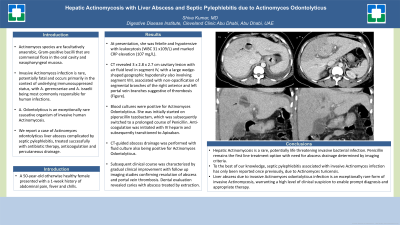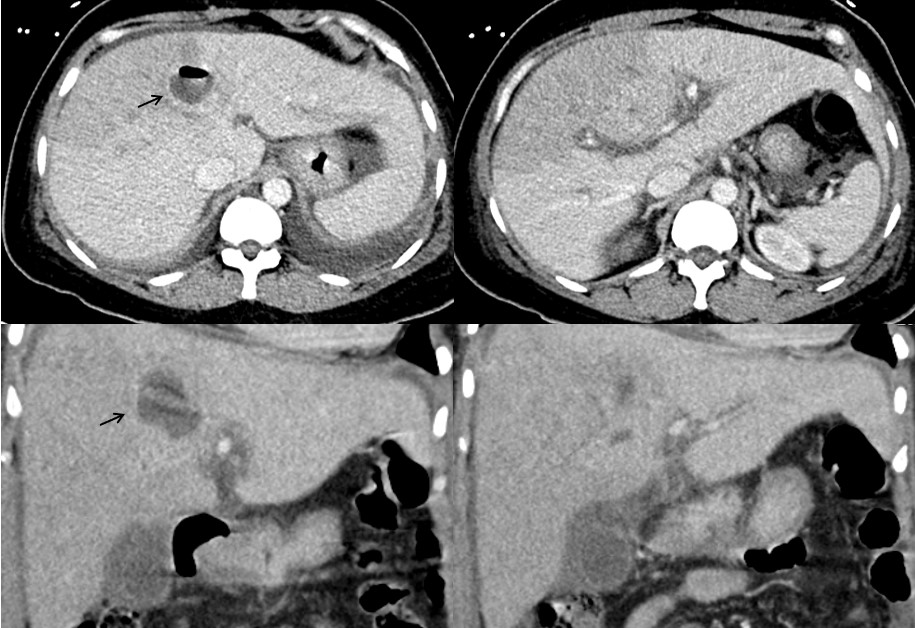Sunday Poster Session
Category: Liver
P1278 - Hepatic Actinomycosis With Liver Abscess and Septic Pylephlebitis due to Actinomyces odontolyticus
Sunday, October 27, 2024
3:30 PM - 7:00 PM ET
Location: Exhibit Hall E

Has Audio
- SK
Shiva Kumar, MD, MHA
Cleveland Clinic
Abu Dhabi, Abu Dhabi, United Arab Emirates
Presenting Author(s)
Shiva Kumar, MD, MHA
Cleveland Clinic, Abu Dhabi, Abu Dhabi, United Arab Emirates
Introduction: Actinomyces species are facultatively anaerobic, Gram-positive bacilli that are commensal flora in the oral cavity and nasopharyngeal mucosa. Invasive Actinomyces infection is rare, potentially fatal and occurs primarily in the context of underlying immunosuppressed status, with A. gerencseriae and A. israelii being most commonly responsible for human infections. A. Odontolyticus is an exceptionally rare causative organism of invasive human Actinomycosis. We report a case of Actinomyces odontolyticus liver abscess complicated by septic pylephlebitis, treated successfully with antibiotic therapy, anticoagulation and percutaneous drainage.
Case Description/Methods: A 50-year-old otherwise healthy female presented with a 1 week history of abdominal pain, fever and chills. At presentation, she was febrile and hypotensive with leukocytosis (WBC 31 x109/L) and marked CRP elevation (107 mg/L). CT revealed 3 x 2.8 x 2.7 cm cavitary lesion with air fluid level in segment IV, with a large wedge-shaped geographic hypodensity also involving segment VIII, associated with non-opacification of segmental branches of the right anterior and left portal vein branches suggestive of thrombosis (Figure). Blood cultures were positive for Actinomyces Odontolyticus. She was initially started on piperacillin tazobactam, which was subsequently switched to a prolonged course of Penicillin. Anti-coagulation was initiated with IV heparin and subsequently transitioned to Apixaban. CT-guided abscess drainage was performed with fluid culture also being positive for Actinomyces Odontolyticus. Subsequent clinical course was characterized by gradual clinical improvement with follow up imaging studies confirming resolution of abscess and portal vein thrombosis. Dental evaluation revealed caries with abscess treated by extraction.
Discussion: Hepatic Actinomycosis is a rare, potentially life threatening invasive bacterial infection. Microbiological confirmation of gram positive filamentous bacteria forms the cornerstone of its diagnosis. Penicillin remains the first line treatment option with need for abscess drainage determined by imaging criteria. To the best of our knowledge, septic pylephlebitis associated with invasive Actinomyces infection has only been reported once previously, due to Actinomyces turicensis. Liver abscess due to invasive Actinomyces odontolyticus infection is an exceptionally rare form of invasive Actinomycosis, warranting a high level of clinical suspicion to enable prompt diagnosis and appropriate therapy.

Disclosures:
Shiva Kumar, MD, MHA. P1278 - Hepatic Actinomycosis With Liver Abscess and Septic Pylephlebitis due to Actinomyces odontolyticus, ACG 2024 Annual Scientific Meeting Abstracts. Philadelphia, PA: American College of Gastroenterology.
Cleveland Clinic, Abu Dhabi, Abu Dhabi, United Arab Emirates
Introduction: Actinomyces species are facultatively anaerobic, Gram-positive bacilli that are commensal flora in the oral cavity and nasopharyngeal mucosa. Invasive Actinomyces infection is rare, potentially fatal and occurs primarily in the context of underlying immunosuppressed status, with A. gerencseriae and A. israelii being most commonly responsible for human infections. A. Odontolyticus is an exceptionally rare causative organism of invasive human Actinomycosis. We report a case of Actinomyces odontolyticus liver abscess complicated by septic pylephlebitis, treated successfully with antibiotic therapy, anticoagulation and percutaneous drainage.
Case Description/Methods: A 50-year-old otherwise healthy female presented with a 1 week history of abdominal pain, fever and chills. At presentation, she was febrile and hypotensive with leukocytosis (WBC 31 x109/L) and marked CRP elevation (107 mg/L). CT revealed 3 x 2.8 x 2.7 cm cavitary lesion with air fluid level in segment IV, with a large wedge-shaped geographic hypodensity also involving segment VIII, associated with non-opacification of segmental branches of the right anterior and left portal vein branches suggestive of thrombosis (Figure). Blood cultures were positive for Actinomyces Odontolyticus. She was initially started on piperacillin tazobactam, which was subsequently switched to a prolonged course of Penicillin. Anti-coagulation was initiated with IV heparin and subsequently transitioned to Apixaban. CT-guided abscess drainage was performed with fluid culture also being positive for Actinomyces Odontolyticus. Subsequent clinical course was characterized by gradual clinical improvement with follow up imaging studies confirming resolution of abscess and portal vein thrombosis. Dental evaluation revealed caries with abscess treated by extraction.
Discussion: Hepatic Actinomycosis is a rare, potentially life threatening invasive bacterial infection. Microbiological confirmation of gram positive filamentous bacteria forms the cornerstone of its diagnosis. Penicillin remains the first line treatment option with need for abscess drainage determined by imaging criteria. To the best of our knowledge, septic pylephlebitis associated with invasive Actinomyces infection has only been reported once previously, due to Actinomyces turicensis. Liver abscess due to invasive Actinomyces odontolyticus infection is an exceptionally rare form of invasive Actinomycosis, warranting a high level of clinical suspicion to enable prompt diagnosis and appropriate therapy.

Figure: CT revealed 3 x 2.8 x 2.7 cm cavitary lesion in segment IV, with a large wedge-shaped geographic hypodensity also involving segment VIII, associated with non-opacification of segmental branches of the right anterior and left portal vein branches.
Disclosures:
Shiva Kumar indicated no relevant financial relationships.
Shiva Kumar, MD, MHA. P1278 - Hepatic Actinomycosis With Liver Abscess and Septic Pylephlebitis due to Actinomyces odontolyticus, ACG 2024 Annual Scientific Meeting Abstracts. Philadelphia, PA: American College of Gastroenterology.
